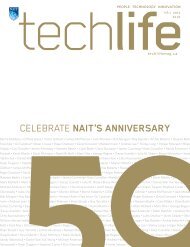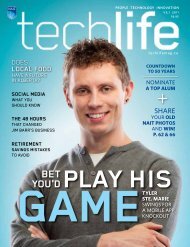CUBA'S - techlife magazine
CUBA'S - techlife magazine
CUBA'S - techlife magazine
You also want an ePaper? Increase the reach of your titles
YUMPU automatically turns print PDFs into web optimized ePapers that Google loves.
photo by jason ness<br />
BEDSIDE<br />
mATTErs<br />
Radiology resident Dr. Anukul panu<br />
(seated) and sonography student<br />
Dana mcClean, with actors posing<br />
as expectant parents<br />
lying in a dimly lit ultrasound suite, you’re full of anticipation as you are about to get a glimpse of your baby.<br />
Friendly banter stops as the sonographer studies her screen. She stands up and says she’s going to check<br />
something with the radiologist. In a heartbeat, you know something is wrong.<br />
The way a medical team delivers bad news has a profound impact on a patient. That’s why NAIT<br />
Diagnostic Medical Sonography students and University of Alberta radiology residents recently took part in a<br />
simulation based on this heart-wrenching scenario.<br />
The exercise, organized by sonography instructor Martie Grant, was part of NAIT’s inter-professional<br />
education initiative, in which students from different medical fields learn with, from and about each other<br />
to improve collaboration and patient care. It was the first simulation of its kind to bring together NAIT<br />
sonography students and University of Alberta radiology residents. Currently, NAIT is working with other postsecondary<br />
institutes to arrange exercises to link students across other health-care programs.<br />
Several “ah-ha” moments came out of that ultrasound simulation. Here’s what the students will take from<br />
it as they begin their careers.<br />
— Ruth Juliebo<br />
PROfeSSIOnalISm<br />
There’s more to being a physician<br />
than being a medical expert. In a<br />
situation where you must deliver bad<br />
news, professionalism is paramount.<br />
Team members must understand each<br />
others’ challenges and stresses . . . and<br />
have deep sympathy and respect for<br />
the patient.<br />
dr. sandeep Naik<br />
Assistant Clinical Professor<br />
Department of Radiology and Diagnostic<br />
Imaging, University of Alberta<br />
COmmunICatIOn<br />
My role is to focus on delivering<br />
the medical information, while the<br />
sonographer can offer the “softer”<br />
touch to comfort the patient. It’s very<br />
helpful for the sonographer to fill me<br />
in on the patient’s history, thoughts<br />
and emotions before I go in.<br />
dr. anukul Panu<br />
Fourth-year resident<br />
Diagnostic Radiology Residency<br />
University of Alberta<br />
INNOVATE<br />
COllaBORatIOn<br />
I learned how much the doctors<br />
appreciate our support. Sonographers<br />
form trusting relationships with the<br />
patients after scanning. . . . If I can<br />
prepare the doctor for that individual’s<br />
circumstance, it will alleviate some<br />
stress both for the doctor and the<br />
patient. We are all part of a team.<br />
dana McClean<br />
Second-year student<br />
Diagnostic Medical Sonography<br />
NAIT<br />
v4.2 2011 35










